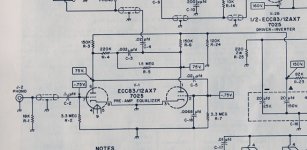I have several LINE LEVEL tube amps. So i built a Solid State
RIAA Magnetic cartridge pre amp to listen to my LP's but that defeats the purpose of tube amps. So I want to build a tube pre amp. I found this circuit from a 1950's amp. It's not much but I think it will meet all my needs, except one. I would like to have a "flat" no equalization pre amp also. the "how it works" section says "equalization is achieved by plate to plate feedback through C-3 and R-4, with R-5 limiting the bass boost to prevent rumble".
How hard would it be to put in a switch or two to change between equalization/ no equalization?
RIAA Magnetic cartridge pre amp to listen to my LP's but that defeats the purpose of tube amps. So I want to build a tube pre amp. I found this circuit from a 1950's amp. It's not much but I think it will meet all my needs, except one. I would like to have a "flat" no equalization pre amp also. the "how it works" section says "equalization is achieved by plate to plate feedback through C-3 and R-4, with R-5 limiting the bass boost to prevent rumble".
How hard would it be to put in a switch or two to change between equalization/ no equalization?
Attachments
Do you want the switch to choose between EQ and no EQ while listening to LPs? As far as I understand, you need RIAA EQ for phono. If the switch is to allow for pre amp of line level inputs, why would you want his? You would end up needing wildly different master volume settings when switching between line level input and LPs. If your other inputs are line level, no need for a pre amp.
No, not switch while listening to LP's. Switch on for LP's with EQ. Switch off for other low leven input without EQ, such as MIC or crystal radio ect.🙂
Not my area of expertese, but I will go out on a limb here and state that for low level signals, you might not want to have the extra lead lengths required to hook all of this up to a switch. Also, switching that very low level signal might cause some thumps or pops? Others might help out here but these are the issues that I would think needed addressing before proceeding.
Cheers,
Chris
Cheers,
Chris
R4 and C3 cannot alone provide RIAA EQ. C18 is providing part of the EQ as well.
Disconnecting R4 and C18 should give you flat response.
I would eliminate R5 altogether unless you actually have a rumble problem.
Disconnecting R4 and C18 should give you flat response.
I would eliminate R5 altogether unless you actually have a rumble problem.
Your circuit is not having RIAA equalization. It is maybe from the era before RIAA became standard. Possibly intended for crystal cartridges.
Secondly, if you want to make switchable EQ to non-EQ, the non-EQ position requires to add some 40 dB (flat) attenuation, since this amount of equalization takes place in RIAA circuitry.
Here: http://r-type.org/static/pre.htm is a link to Mullard preamplifier where the equalization and gain is switched in different positions. By modifying this you can do something like you asked for.
Secondly, if you want to make switchable EQ to non-EQ, the non-EQ position requires to add some 40 dB (flat) attenuation, since this amount of equalization takes place in RIAA circuitry.
Here: http://r-type.org/static/pre.htm is a link to Mullard preamplifier where the equalization and gain is switched in different positions. By modifying this you can do something like you asked for.
Last edited:
The circuit shown by the OP uses grid leak bias for the second stage, where signal levels will be higher. Not a good idea.
If you want a simple RIAA valve circuit the classic one by RCA is not too bad. Don't make it switchable, just use a separate grounded cathode stage for straight amplification of other low level sources.
If you want a simple RIAA valve circuit the classic one by RCA is not too bad. Don't make it switchable, just use a separate grounded cathode stage for straight amplification of other low level sources.
- Status
- Not open for further replies.
- Home
- Amplifiers
- Tubes / Valves
- RIAA Preamp and equalization 12AX7
